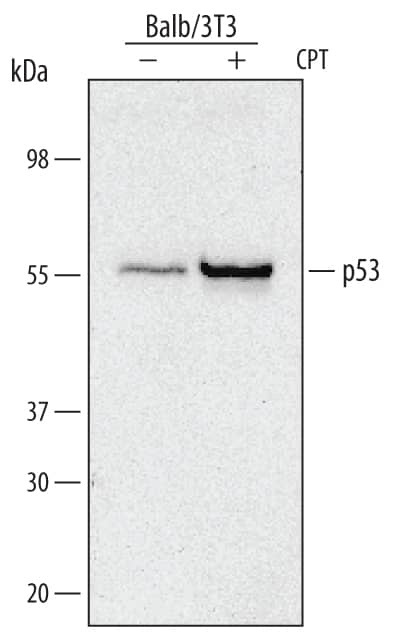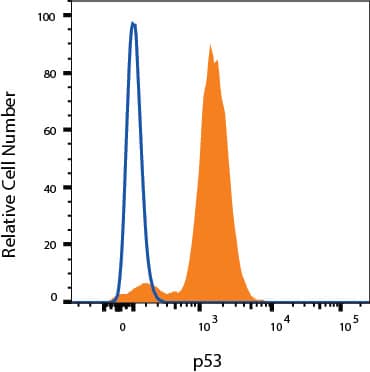Mouse p53 Antibody Summary
Leu28-Phe325
Accession # NP_035770
Customers also Viewed
Applications
Please Note: Optimal dilutions should be determined by each laboratory for each application. General Protocols are available in the Technical Information section on our website.
Scientific Data
 View Larger
View Larger
Immunoprecipitation of Mouse p53. Balb/3T3 mouse embryonic fibroblast cell line was untreated (-) or treated (+) with 1 µM camptothecin (CPT) for 6 hours. p53 was immunoprecipitated from 500 µg of cell lysate following incubation with 1-3 µg Rat Anti-Mouse p53 Monoclonal Antibody (Catalog # MAB1746) for 1 hour on ice. p53-antibody complexes were absorbed using goat anti-rat IgG sepharose (Invitrogen). Immunoprecipitated p53 was detected by Western blot using a 1:5000 dilution of Human/Mouse/Rat p53 Horseradish Peroxidase-conjugated Antigen Affinity-purified Polyclonal Antibody (HAF1355). View our recommended buffer recipes for immunoprecipitation.
Preparation and Storage
- 12 months from date of receipt, -20 to -70 °C as supplied.
- 1 month, 2 to 8 °C under sterile conditions after reconstitution.
- 6 months, -20 to -70 °C under sterile conditions after reconstitution.
Background: p53
The p53 tumor suppressor protein is a multi-functional transcription factor that regulates cellular decisions regarding proliferation, cell cycle checkpoints, and apoptosis. The importance of p53 is underscored by its mutation in over 50% of human cancers. Mice that lack one or both copies of p53 also showed an increased incidence of tumors, which makes the p53 deficient mouse a model system for studying cancer generation and progression.
Product Datasheets
Citations for Mouse p53 Antibody
R&D Systems personnel manually curate a database that contains references using R&D Systems products. The data collected includes not only links to publications in PubMed, but also provides information about sample types, species, and experimental conditions.
4
Citations: Showing 1 - 4
Filter your results:
Filter by:
-
Combined HDAC1 and HDAC2 Depletion Promotes Retinal Ganglion Cell Survival After Injury Through Reduction of p53 Target Gene Expression
Authors: Frédéric Lebrun-Julien, Ueli Suter
ASN Neuro
-
Cancer cells same as zombies reprogram normal cells via the secreted microenvironment
Authors: Rabiee, S;Hoveizi, E;Barati, M;Salehzadeh, A;Joghataei, MT;Tavakol, S;
PloS one
Species: Mouse
Sample Types: Cell Lysates
Applications: Western Blot -
Early-life nutrition influences thymic growth in male mice that may be related to the regulation of longevity.
Authors: Chen JH, Tarry-Adkins JL, Heppolette CA, Palmer DB, Ozanne SE
Clin. Sci., 2009-12-14;118(6):429-38.
Species: Mouse
Sample Types: Tissue Homogenates
Applications: Western Blot -
Adverse effects of reduced oxygen tension on the proliferative capacity of rat kidney and insulin-secreting cell lines involve DNA damage and stress responses.
Authors: Chen JH, Jones RH, Tarry-Adkins J, Smith NH, Ozanne SE
Exp. Cell Res., 2008-07-28;314(16):3075-80.
Species: Rat
Sample Types: Cell Lysates
Applications: Western Blot
FAQs
No product specific FAQs exist for this product, however you may
View all Antibody FAQsIsotype Controls
Reconstitution Buffers
Secondary Antibodies
Reviews for Mouse p53 Antibody
There are currently no reviews for this product. Be the first to review Mouse p53 Antibody and earn rewards!
Have you used Mouse p53 Antibody?
Submit a review and receive an Amazon gift card.
$25/€18/£15/$25CAN/¥75 Yuan/¥2500 Yen for a review with an image
$10/€7/£6/$10 CAD/¥70 Yuan/¥1110 Yen for a review without an image















